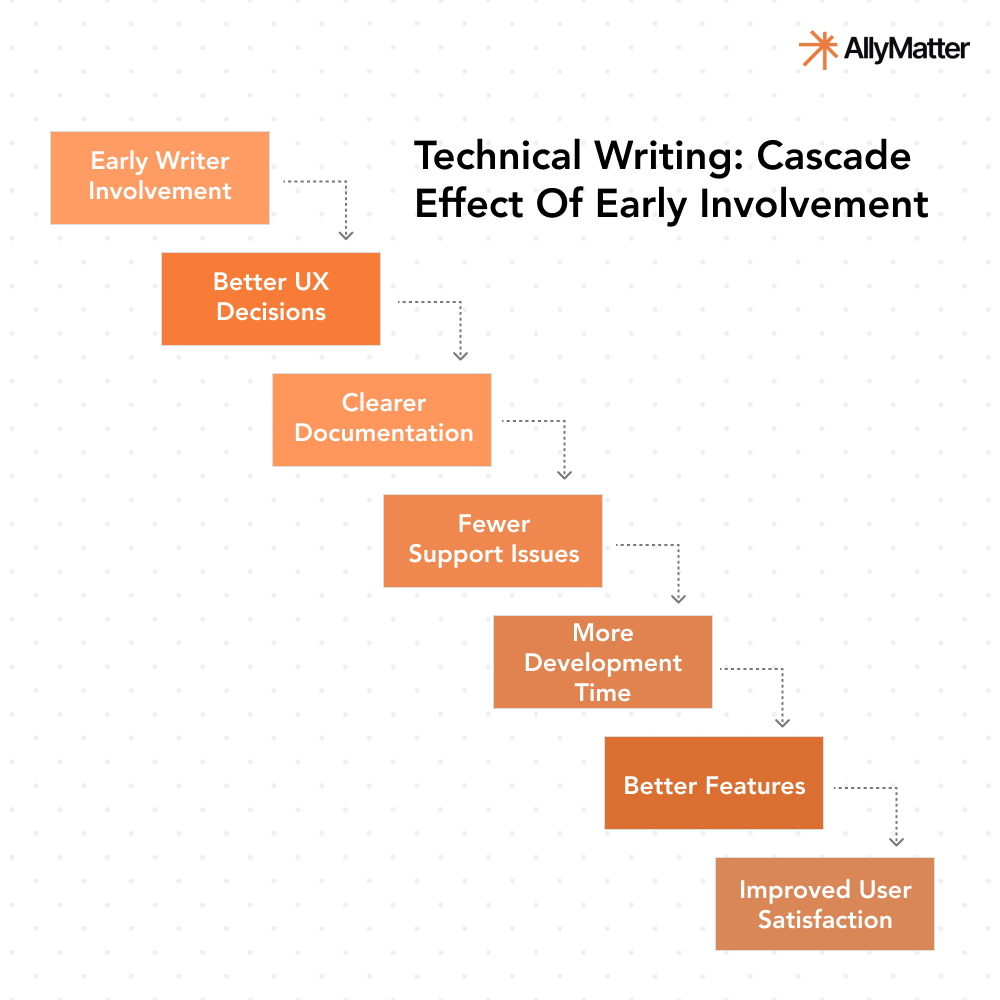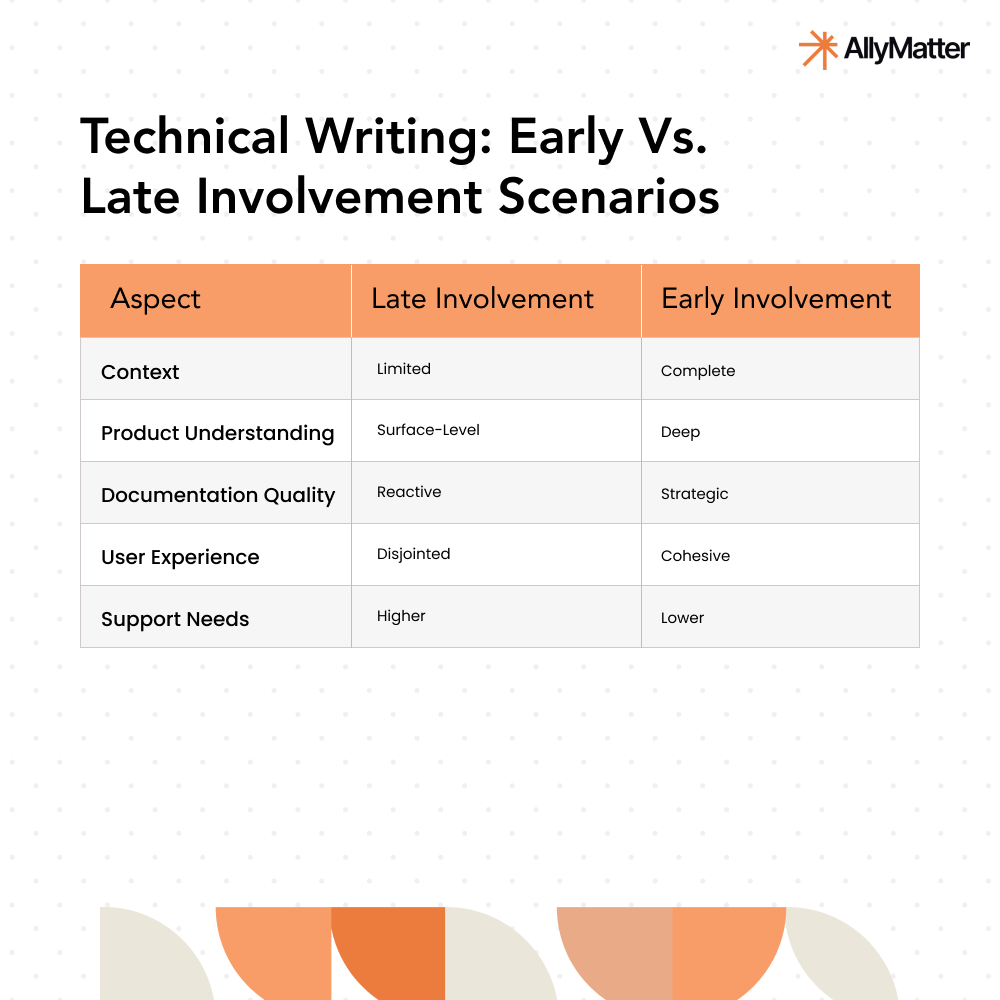
Imagine this: Your team just launched a new feature after months of hard work. Everything seems perfect until customer support reports a flood of confused users. The documentation is confusing because the writer only saw the product days before launch. Sound familiar?
Most teams bring in technical writers at the last minute, treating documentation as an afterthought. But what if involving writers from the very beginning could not only improve your documentation but make your product better too?
The last-minute documentation scramble
When technical writers join late in the process, they face an uphill battle. Consider a typical scenario:
Sarah, a technical writer, receives an urgent email on Thursday: “The new analytics dashboard launches Monday. Can you write up the documentation?” She has never seen the feature, wasn’t involved in any planning, and now must scramble to understand complex functionality while racing against the clock.
The result? Documentation that misses key workflows, uses inconsistent terminology, and fails to address real user questions. No wonder users get frustrated and flood support channels.
For too many organizations, technical documentation remains an afterthought, something to be rushed together before release after the “real work” is done. This approach leads to predictable problems: documentation not matching the final product, frustrated users, increased support costs, and burned-out writers trying to understand complex systems under tight deadlines.
What changes when writers join early
Now imagine a different approach. Sarah is invited to the initial planning meeting for the analytics dashboard. As the team discusses features, she asks questions like:
- “How will users navigate between different report types?”
- “What terms should we use consistently throughout the interface and documentation?”
- “What previous feature does this replace, and how do we help users transition?”
These questions don’t just improve documentation; they improve the product itself.
The business case for early documentation involvement
[ADDED] When technical writers participate in early planning meetings and design discussions, they bring a unique perspective that helps identify potential user pain points, clarity issues, and documentation needs before they become costly problems:
- Reduced costs: Issues identified early in the design phase are significantly cheaper to fix than those discovered after development. Technical writers often spot usability problems, confusing terminology, or implementation inconsistencies that might otherwise slip through.
- Increased efficiency: With writers involved from the beginning, documentation evolves alongside the product rather than being frantically created at the end. This parallel development eliminates the “documentation debt” that often creates bottlenecks before release.
- Enhanced user experience: Technical writers are user advocates who constantly ask, “Will this make sense to someone who hasn’t been in our planning meetings?” This perspective often leads to more intuitive interfaces and clearer workflows.
Real-world impacts
Involvement of technical writers at the beginning triggers a series of downstream benefits.

Consider this hypothetical example:
A software company developing a project management tool brought their technical writer, Miguel, into planning meetings for a new task automation feature. During discussions, Miguel pointed out that the proposed workflow used different terminology than existing features.
This simple observation led to:
- Revised interface text that used consistent language
- Clearer documentation that connected the new feature to existing ones
- A more intuitive user experience
- Fewer support tickets after launch
The product manager later estimated they saved weeks of post-launch fixes and significantly reduced user confusion. This aligns with McKinsey research showing that employees spend nearly 20% of their workweek looking for internal information or tracking down colleagues for help, a problem that proper documentation planning can significantly reduce.
How technical writers contribute beyond documentation
Technical writers bring unique perspectives to development:
- User advocates: Writers approach products from the user’s perspective, not the developer’s. They ask the “how will someone figure this out?” questions that technical teams might overlook.
- Clarity experts: Writers excel at spotting confusing terminology or workflows before they’re coded into the product.
- Experience connectors: Good writers help ensure new features fit logically with existing functionality and documentation.
- Question askers: Writers ask the questions that future users will ask; better to answer them during development than after launch.
- Language precision: Writers help streamline API naming conventions, improve UI labeling, and create consistent terminology across the product. This linguistic consistency makes products more intuitive and reduces the learning curve for users.
- Identifying gaps: Good technical writers have a talent for spotting missing information or unexplained functionality. “What happens if the user does X?” or “How does this interact with feature Y?” These questions often uncover edge cases or integration issues early in the development cycle.
Technical writers as knowledge custodians
Beyond creating end-user documentation, technical writers serve as invaluable knowledge managers throughout the development process:
- Organizational memory: How many times has your team asked, “Where are the specs for this feature?” or “Didn’t we discuss this already?” Technical writers excel at organizing internal project documentation, creating and maintaining centralized repositories, and ensuring critical information doesn’t get lost in endless email threads or chat conversations. As one senior developer put it: “Our technical writer knows where everything is documented. She’s our in-house loremaster.”
- Continuous documentation: When writers are integrated into the development process, documentation evolves naturally with each sprint or milestone. Changes are captured as they happen rather than reconstructed weeks or months later. This approach ensures accuracy and dramatically reduces the end-of-project documentation crunch that so often leads to quality issues.
Breaking down silos: Writers as cross-functional team members
The most effective technical writing happens when writers are fully integrated into development teams:
- Participation in the full lifecycle: From initial brainstorming through design, development, testing, and release, technical writers add value at every stage. They can help clarify requirements, document design decisions, create user-friendly error messages, develop testing scenarios, and prepare release notes, all while building comprehensive documentation.
- Cross-team communication: Technical writers often work across multiple teams, giving them a broader perspective on how different components interact. This position makes them valuable connectors who can facilitate knowledge transfer between specialized teams.
- Documentation that reflects reality: When writers witness the development process firsthand, they create documentation that reflects how the product actually works, not just how it was intended to work. This accuracy is crucial for user trust and adoption.
A day in the life: Early vs. late involvement
Late involvement: The writer gets a near-final product, spends days trying to understand it, creates documentation based on guesswork, and users still end up confused.
Early involvement: The writer understands the feature’s purpose from day one, helps shape intuitive workflows, creates documentation that evolves with the product, and users find answers easily.

Getting started: Simple steps for early writer involvement
You don’t need to overhaul your entire process overnight. Try these steps:
- Invite writers to kickoff meetings: Even if they’re just listening, they’ll gain valuable context.
- Share prototypes and mockups: Let writers see early designs and provide feedback from a documentation perspective.
- Review terminology together: Spend 30 minutes aligning on key terms and how features will be described.
- Include documentation in definition of “done”: Make documentation part of your completion criteria, not an afterthought.
Implementing the integrated approach
Bringing technical writers into the early stages of development requires some adjustments:
- Team structure: Consider where technical writers fit in your organization. Are they part of engineering teams? Product teams? A separate documentation department? The most successful models usually involve writers being embedded with development teams while maintaining connections to other writers for consistency.
- Process integration: Define clear touch points for documentation throughout your development process. Include documentation tasks in sprint planning, feature kickoffs, and review cycles.
- Collaboration tools: Ensure writers have access to the same tools as developers – code repositories, issue trackers, design documents, and testing environments. This access is essential to create accurate, timely documentation.
- Cultural shift: Perhaps most importantly, foster a culture that values documentation as an integral part of the product, not just an accessory. Recognize that good documentation reflects good design and clear thinking.
Overcoming common challenges
Here’s how to address typical concerns:
- “We don’t have the resources”: Even limited early involvement is better than none. If you can’t include writers in every meeting, prioritize kickoffs and major review points.
- “Developers resist writer involvement”: Start small. Position writers as helpers who make developers’ lives easier by reducing support questions and user confusion.
- “Our writers are too busy”: Consider that early involvement often reduces total documentation time by preventing rework and confusion.
The future of technical documentation in product development
As products become more complex and user expectations rise, the role of technical writers continues to evolve:
- Documentation-driven development: Some teams are now using documentation as a design tool, writing the user guide before writing code to ensure the product is intuitive and sensible from the user’s perspective.
- Integrated documentation tools: Modern development environments increasingly support embedded documentation that lives alongside code, making it easier to keep documentation and functionality synchronized.
- Strategic information architecture: Technical writers are becoming information strategists who design holistic knowledge systems spanning multiple formats and platforms—from traditional manuals to interactive guides, videos, chatbots, and embedded help.
How AllyMatter transforms documentation collaboration
Growing companies often struggle with documentation scattered across multiple platforms, making early writer collaboration difficult. AllyMatter’s centralized knowledge management platform enables technical writers and development teams to work together seamlessly from project inception.
Smart approval workflows ensure documentation standards remain consistent across all development phases, while granular access control lets writers collaborate with different teams without compromising sensitive information. Built-in version tracking means everyone stays aligned on the latest specifications, and intelligent organization through custom categories ensures that knowledge sharing evolves naturally with your development process.
The platform’s comprehensive audit trail provides the transparency that both writers and developers need to track decisions and changes throughout the product lifecycle, eliminating the confusion that often arises when documentation is created as an afterthought.
From documentation afterthought to strategic advantage
Involving technical writers from the beginning of your development process isn’t just about better documentation; it’s about building better products. Writers bring unique perspectives that can identify problems before they’re coded, create more intuitive user experiences, and ultimately reduce support costs and improve user satisfaction.
Good documentation isn’t just about explaining what you built; it’s also about building something worth explaining. By including technical writers from the beginning of your development process, you gain not only better documentation but also better products, more efficient teams, and happier users.
The next time you kick off a new feature or product, ask yourself: “Should our technical writer be in this meeting?” The answer is probably yes.
Ready to eliminate knowledge silos and streamline your team’s documentation process? Join our waitlist to discover how AllyMatter can transform your scattered information into organized, accessible knowledge that evolves with your team.
Frequently asked questions
When should technical writers join product development teams?
Technical writers should participate from initial planning meetings, not just before launch. Early involvement allows them to influence product terminology, identify potential user experience issues, and develop knowledge sharing processes that evolve alongside product development.
How do technical writers contribute beyond creating documentation?
Writers serve as user advocates who ask critical questions about workflow clarity and terminology consistency. They help identify potential confusion points before they’re implemented, often preventing costly post-launch fixes and reducing employee self-service challenges.
What business value does early writer involvement provide?
Early writer participation reduces development costs by identifying issues during design phases, decreases support volumes through clearer user experiences, and eliminates documentation bottlenecks that often delay product releases.
How can growing companies implement this approach with limited resources?
Start by including writers in project kickoffs and major review sessions. Share prototypes early and establish consistent terminology guidelines. Even minimal early involvement prevents the knowledge silos that create larger problems later.
What challenges might teams face when integrating writers early?
Common concerns include resource allocation and developer resistance. Position writers as efficiency enhancers who reduce future support burdens and user confusion rather than additional overhead.


